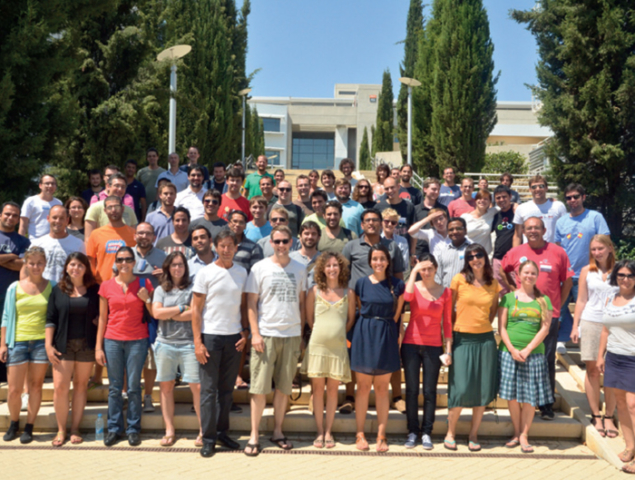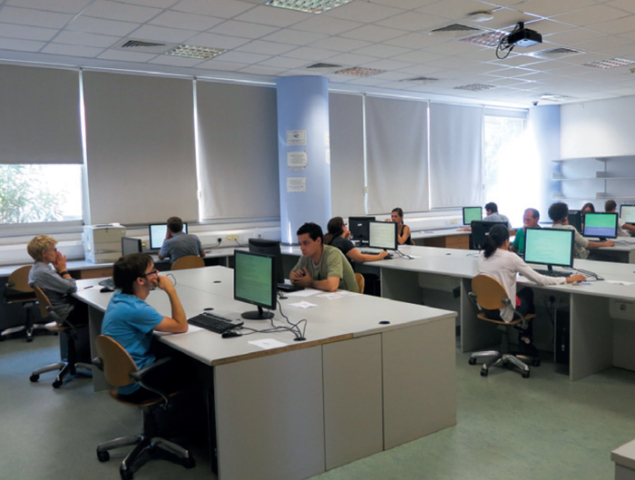How the CSC has been reinvigorated during the past decade.

Image credit: G Lo Presti.
On 29 August 2013, on the ground floor of Building FST01 of the Faculty of Pure and Applied Sciences at the University of Cyprus in Nicosia, 31 students filed silently into the two classrooms of the CERN School of Computing and took a seat in front of a computer. An hour later they were followed by a second wave of 31 students. They were all there to participate in the 12th occasion of a unique CERN initiative – the final examination of its computing school.
The CERN School of Computing (CSC) is one of the three schools that CERN has set up to deliver knowledge in the organization’s main scientific and technical pillars – physics, accelerators and computing. Like its counterparts, the CERN Accelerator School and what is now the European School of High-Energy Physics, each year it attracts several-dozen participants from across the world for a fortnight of activities relating to its main topic.
How and why was the CSC set up? On 23 September 1968, future director-general Léon van Hove put forward a proposal to the then director-general, Bernard Gregory, for the creation of a summer school on data handling. This followed a recommendation made on 21 May 1968 to the Academic Training Committee by Ross MacLeod, head of the Data and Documents Division, the forerunner of today’s Information Technology Department. The proposal recommended that a school be organized in summer 1969 or 1970. The memorandum from van Hove to Gregory gave a visionary description of the potential audience for this new school: “It would address a mixed audience of young high-energy physicists and computer scientists.” Forty-five years later, not a word needs to be changed.
The justification for the school was also prophetic: “One of the interests of the Data Handling Summer School lies in the fact that it would be useful not only for high-energy physicists but also for those working in applied mathematics and computing. It would be an excellent opportunity for CERN to strengthen its contacts with a field which may well play a growing role in the long-range future.” With the agreement of Mervyn Hine, director of research, Gregory approved the proposal on 15 November 1968 and on 20 December MacLeod proposed a list of names to van Hove to form the first organizing committee. Alongside people from outside CERN – Bernard Levrat, John Burren and Peter Kirstein – were Tor Bloch, Rudi Böck, Bernard French, Robert Hagedorn, Lew Kowarski, Carlo Rubbia and Paolo Zanella from CERN.

Image credit: F Fluckiger.
The first CSC was not held at CERN as initially proposed but in Varenna, Italy, in 1970. It was realized quickly that the computing school – with the physics and accelerator schools – could be effective for collaboration between national physics communities and CERN. Until 1986 the CSC was organized every other year, then yearly starting with the school in Troia, Portugal, in 1987. To date there have been 36 schools, attended by 2300 students from five continents.
Ten years ago, I took over the reins of the school and proposed a redefinition of its objectives as it entered its fourth decade: “The school’s main aim is to create and share a common culture in the field of scientific computing, which is a strategic necessity to promote mobility within CERN and between institutes, and to carry out large transnational computing projects. The second aim is the creation of strong social links between participants, students and teachers alike, to reinforce the cohesion of the community and improve the effectiveness of its shared initiatives. The school should be open to computer scientists and physicists and ensure that both groups get to know each other and acquire a solid grounding in whichever of these domains is not their own.”
Moreover, the new management proposed three major changes of direction. First, they vowed to reinvigorate the resolutely academic dimension of the CSC, which during the years had gradually and imperceptibly become more like a conference. Conferences are necessary for scientific progress – they are forums where people can present their work, have their ideas challenged, have fruitful discussions about controversial issues and talk about themselves and what they do. The interventions at conferences are short, sometimes redundant or contradictory. The transmission of facts and opinions becomes more prominent than the transfer of knowledge. I took the view that this should not be the primary role of the CSC, since conferences such as the Computing in High-Energy Physics series serve this purpose perfectly. The academic dimension was therefore progressively re-established through the implementation of three principles.
Three principles
The first academic principle concerns the organization of the teaching. A deliberately limited number of teachers – each giving a series of lessons of several hours – ensures coherence between the different classes, avoids redundancy and delivers consistent content, more than a series of short interventions. Moreover, for several years now all of the non-CERN teachers have been university professors. This is not the result of a strict policy but it is worthy of note that the choice of teachers has been consistent with this academic ambition.

Image credit: J Hammer.
The second principle for restoring the academic dimension concerns the school’s curriculum. The main accent is on the transmission of knowledge and not of know-how. In this way, the CSC differs from training programmes organized by the laboratories and institutes, which are focused on know-how. The difference between knowledge and know-how is an important principle in the field of learning sciences. To get a better understanding of this distinction, the management of the school established relations with experts in the field at an early stage, particularly at the University of Geneva.
Knowledge is made up of fundamental concepts and facts on which additional knowledge is built and developed to persist over time
What are the differences? Knowledge is made up of fundamental concepts and facts on which additional knowledge is built and developed to persist over time. Moreover, the student acquires knowledge, incorporates it into his or her personal knowledge corpus and transforms it. Two physicists never have the same understanding of quantum mechanics. On the other hand, know-how – which includes methods and the use of tools – can generally be acquired autonomously with few prerequisites. With the exception of physical skills – such as knowing how to ride a bike or swim – which we tend not to lose, know-how requires regular practise so that it is not forgotten. Knowledge is more enduring by nature. Finally – and this is one of the main differences – knowledge can be transposed more readily to other environments and adapted to new problems. That at least is the theory. In practice, the differences are sometimes less clear. This is the challenge with which the CSC tries to get to grips each year when defining its programme – are we really operating mainly in the field of knowledge? The school is made up in equal parts of lectures and hands-on sessions, so do the latter not relate more to know-how? Yes, but the acquisition of this know-how is not an end in itself – it provides knowledge with a better anchorage.
The third principle of the academic dimension is evaluation of the knowledge acquired and recognition of the required level of excellence with a certificate. Following requests from students who wanted the high level of knowledge gained during the school to be formally certified, the CSC Diploma was introduced in 2002 to recognize success in the final exam and vouch for the student’s diligence throughout the programme. To date, 671 students have been awarded the CSC Diploma, which often figures prominently in their CVs. But that’s not all. Since 2008, the academic quality of the school, its teachers and exam has been formally audited each year by a different independent university. Each autumn, the school management prepares a file that is aimed at integrating the next school into the academic curriculum of the host university. The universities of Brunel, Copenhagen, Gjøvik, Göttingen, Nicosia and Uppsala have analysed and accepted CERN’s request. As a result, they have each awarded a formal European Credit Transfer System (ECTS) certificate to complement the CERN diploma.
This academic reorientation of the school is one of the three main renewal projects undertaken during the past 10 years. The second relates to the school’s social dimension. The creation of social links and networks between the participants and with their teachers has become the school’s second aim. This is considered to be a strategic objective because not only does it reinforce the cohesion of the community, it also improves the efficiency of large projects or services, such as the Worldwide LHC Computing Grid, through improved mutual understanding between the individuals contributing to them.

The main vehicle chosen for socialization is sport. Every afternoon, a large part of the timetable is freed up for a dozen indoor and outdoor sports. Tennis, climbing or swimming lessons are given, often by the school’s teachers. Each year, participants discover an activity that is new to them, such as horse riding, sailing, canoeing, kayaking, scuba diving, rock climbing, cricket and mountain biking. The sport programme is supported by the CERN Medical Service and is associated with the “Move! Eat better” initiative. A second vehicle for socialization – music – is being considered and could be introduced for future schools. The intention is to give those who are interested the opportunity each afternoon to take part in instrumental music or choral singing or to discover them for the first time, with the same aim as for sport of “doing things together to get to know each other better”.
The third renewal project is plurality. In contrast to CERN’s high-energy physics and accelerator schools, which have organized several annual events for a number of years, the CSC has long remained the organization’s only school in the field of computing. However, since 2005 the CSC management has organized the inverted CSC (iCSC, “Where students turn into teachers”) and starting in 2013 the thematic CSC (tCSC). The idea behind the inverted school is simple – to capitalize on the considerable amount of knowledge accumulated by the participants in a school by inviting them to teach one or more lessons at a short school of three to five half-days, organized at CERN at the mid-point between two summer schools. To date, 40 former students have taught at one of these inverted schools.
It should be noted that the academic principle is still predominant. The goal is not to talk about oneself or one’s project but to present a topic, an innovative one if possible. This is not always easy, so each young teacher who is selected is assigned a mentor who follows the design and production of the lesson across three months. The inverted school has another aim – it is also a school for learning to teach. It represents the second link in a chain of training stages for new teachers for the main school. The first link, for those who are interested, is to give a short academic presentation while attending the main school. After the iCSC, i.e. the second link, some are invited to give an hour’s lesson at the main school before the last stage – their full integration into the teaching staff. This process generally takes several years.
During the latest CSC in Nicosia, five out of the 11 teachers were younger than 35. Three of them had passed through the CSC training chain. Along with their forthcoming colleagues, they are the future of the school. Leaving the CSC after 11 years as its director, I am confident that the next generation is ready to take up the baton.







